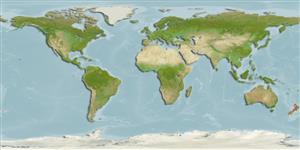>
Blenniiformes (Blennies) >
Tripterygiidae (Triplefin blennies) > Tripterygiinae
Etymology: Notoclinops: Greek, noton = back + Greek, klinein, kline = sloping and also bed, due to the four apophyses of sphenoid bone + Greek, ops = appearance (Ref. 45335).
Environment: milieu / climate zone / depth range / distribution range
Ecología
marino demersal; rango de profundidad 0 - 40 m (Ref. 9003). Subtropical
Southwest Pacific: mainland New Zealand.
Tamaño / Peso / Age
Maturity: Lm ? range ? - ? cm
Max length : 4.4 cm SL macho / no sexado; (Ref. 13227)
Short description
Claves de identificación | Morfología | Morfometría
Espinas dorsales (total) : 20 - 23; Radios blandos dorsales (total) : 10 - 13; Espinas anales: 1; Radios blandos anales: 24 - 25. Pinkish over head and body with faint brown lines on head, nine evenly spaced reddish brown vertical bands on body. Dorsal fins pinkish with a thin colorless stripe running horizontally. Distinguished from other triplefins, other than Notoclinops caerulepunctus by the bright blue eyes.
Adults prefer areas of broken rock, steep rock faces and overhangs in areas without large algae and a thick cover of crustose coralline algae. They feed on small crustaceans (e.g. amphipods and copepods). They remove parasites from larger fish. Males are territorial during the breeding season dutifully guarding the eggs in the nests (Ref. 9003). Eggs are hemispherical and covered with numerous sticky threads that anchor them in the algae on the nesting sites (Ref. 240). Larvae are planktonic which occur primarily in shallow, nearshore waters (Ref. 94114).
Life cycle and mating behavior
Maturities | Reproducción | Spawnings | Egg(s) | Fecundities | Larva
Fricke, R., 1994. Tripterygiid fishes of Australia, New Zealand and the southwest Pacific Ocean (Teleostei). Theses Zool. 24:1-585. (Ref. 13227)
IUCN Red List Status (Ref. 130435)
Threat to humans
Harmless
Human uses
Pesquerías: sin interés
Herramientas
Special reports
Download XML
Fuentes de Internet
Estimates based on models
Preferred temperature (Ref.
123201): 15.1 - 19.5, mean 17.7 °C (based on 24 cells).
Phylogenetic diversity index (Ref.
82804): PD
50 = 0.6250 [Uniqueness, from 0.5 = low to 2.0 = high].
Bayesian length-weight: a=0.00661 (0.00340 - 0.01283), b=3.10 (2.92 - 3.28), in cm total length, based on LWR estimates for this species & (Sub)family-body (Ref.
93245).
Nivel trófico (Ref.
69278): 3.3 ±0.0 se; based on diet studies.
Resiliencia (Ref.
120179): Alto, población duplicada en un tiempo mínimo inferior a 15 meses (Preliminary K or Fecundity.).
Fishing Vulnerability (Ref.
59153): Low vulnerability (10 of 100).
Nutrients (Ref.
124155): Calcium = 606 [247, 2,131] mg/100g; Iron = 3.65 [1.57, 7.97] mg/100g; Protein = 18.7 [17.2, 20.0] %; Omega3 = 0.43 [0.15, 1.27] g/100g; Selenium = 36.2 [9.7, 109.1] μg/100g; VitaminA = 9.12 [1.81, 48.47] μg/100g; Zinc = 2.66 [1.34, 4.66] mg/100g (wet weight);
